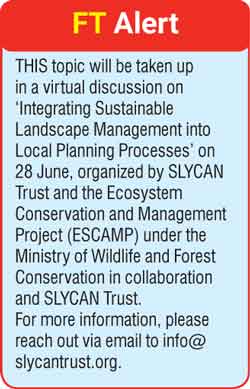Wednesday Jul 02, 2025
Wednesday Jul 02, 2025
Saturday, 26 June 2021 00:00 - - {{hitsCtrl.values.hits}}

 Sri Lanka, along with India’s Western Ghats, is one of 34 global biodiversity hotspots and home to numerous bountiful ecosystems. Despite being only 65,610 square km in size, Sri Lanka’s ecosystems range from beaches, coral reefs, seagrass beds, mangroves, lagoons, and estuaries to grasslands, lowland rainforests, tropical montane forests, and anthropogenic agricultural ecosystems. However, with a growing population, development needs, and the impacts of climate change, these ecosystems are increasingly under threat and have been partially degraded, fragmented, or destroyed over the past decades.
Sri Lanka, along with India’s Western Ghats, is one of 34 global biodiversity hotspots and home to numerous bountiful ecosystems. Despite being only 65,610 square km in size, Sri Lanka’s ecosystems range from beaches, coral reefs, seagrass beds, mangroves, lagoons, and estuaries to grasslands, lowland rainforests, tropical montane forests, and anthropogenic agricultural ecosystems. However, with a growing population, development needs, and the impacts of climate change, these ecosystems are increasingly under threat and have been partially degraded, fragmented, or destroyed over the past decades.
Healthy and thriving ecosystems are vital for human survival and provide a variety of ecosystem services. These benefits from natural or anthropogenic ecosystems include provisioning of goods such as clean water, food, timber, or medicinal and cosmetic ingredients, but also less tangible services like nutrient cycling, climate regulation, or carbon sequestration. Ecosystems also offer essential foundations for human livelihoods and hold immense cultural, recreational, and spiritual value. Furthermore, they provide hatcheries, nurseries, and habitats for Sri Lanka’s biodiversity, much of which is endemic and found nowhere else in the world.
Sri Lanka’s ecosystems and biodiversity are crucial allies against climate change and provide countless benefits to humans. At the same time, they share a space with humans and are increasingly becoming part of a landscape that is shaped by anthropogenic activities. To protect Sri Lanka’s unique biodiversity and diverse ecosystems, integrated landscape management can provide part of the solution.
During national and local planning processes, a landscape management approach combines natural resource management, environmental protection, and livelihood development. It ensures that ecosystem services are utilised, not overexploited, and that local communities can develop and build new income sources that do not harm wildlife or the environment. Landscape management also accounts for human activities and includes institutional structures to address threats and challenges in a holistic and efficient manner by:
 Managing an extended area with such an integrated approach requires long-term collaboration between government institutions, local communities, and other land users, harmonizing their different objectives, needs, and expectations. Therefore, an important part of landscape management is collecting data and understanding who owns or uses the land, what their development needs are, how they benefit from ecosystem services, and how they can contribute to a participatory planning process.
Managing an extended area with such an integrated approach requires long-term collaboration between government institutions, local communities, and other land users, harmonizing their different objectives, needs, and expectations. Therefore, an important part of landscape management is collecting data and understanding who owns or uses the land, what their development needs are, how they benefit from ecosystem services, and how they can contribute to a participatory planning process.
An inclusive and holistic planning process maps key needs, initiatives, and opportunities while also identifying the livelihoods most suitable for the area based on enabling environmental and socioeconomic factors. Climate risk and vulnerability assessments help to ensure that long-term planning processes at local level are holistic and facilitate evidence-based long-term planning. In addition, landscape management plans connect to the localization of Sustainable Development Goals and national development priorities as well as Sri Lanka’s provincial adaptation plans to climate change impacts.
Integrated landscape management that includes ecosystems as well as livelihoods can bring together sectors such as agriculture, forestry, and biodiversity and allow for sustainable, climate-friendly, and resilient development.
(The writer works as Director – Research & Knowledge Management at SLYCAN Trust, a non-profit think tank based in Sri Lanka. His work focuses on climate change, adaptation, just transition, human mobility, and a range of related issues. He holds a Master’s degree in Education from the University of Cologne, Germany and is a regular writer to several international and local media outlets.)
Discover Kapruka, the leading online shopping platform in Sri Lanka, where you can conveniently send Gifts and Flowers to your loved ones for any event including Valentine ’s Day. Explore a wide range of popular Shopping Categories on Kapruka, including Toys, Groceries, Electronics, Birthday Cakes, Fruits, Chocolates, Flower Bouquets, Clothing, Watches, Lingerie, Gift Sets and Jewellery. Also if you’re interested in selling with Kapruka, Partner Central by Kapruka is the best solution to start with. Moreover, through Kapruka Global Shop, you can also enjoy the convenience of purchasing products from renowned platforms like Amazon and eBay and have them delivered to Sri Lanka.
Discover Kapruka, the leading online shopping platform in Sri Lanka, where you can conveniently send Gifts and Flowers to your loved ones for any event including Valentine ’s Day. Explore a wide range of popular Shopping Categories on Kapruka, including Toys, Groceries, Electronics, Birthday Cakes, Fruits, Chocolates, Flower Bouquets, Clothing, Watches, Lingerie, Gift Sets and Jewellery. Also if you’re interested in selling with Kapruka, Partner Central by Kapruka is the best solution to start with. Moreover, through Kapruka Global Shop, you can also enjoy the convenience of purchasing products from renowned platforms like Amazon and eBay and have them delivered to Sri Lanka.